Tesco Marketing: Process, Planning, Mix, and Business Objectives
VerifiedAdded on 2023/06/15
|22
|5357
|456
Report
AI Summary
This report provides an overview of Tesco's marketing process and planning in the 21st century. It explains the role of marketing functions, including promotion, selling, product management, pricing, information management, financing, and distribution, and analyzes their interaction with other departments such as finance, sales, HR, and operations. The report evaluates Tesco's extended marketing mix (product, price, place, promotion) and its contribution to meeting business objectives. Recommendations, such as focusing on relationship marketing, are provided to enhance marketing operations. The report concludes that modern marketing is cost-effective and essential for organizational success.
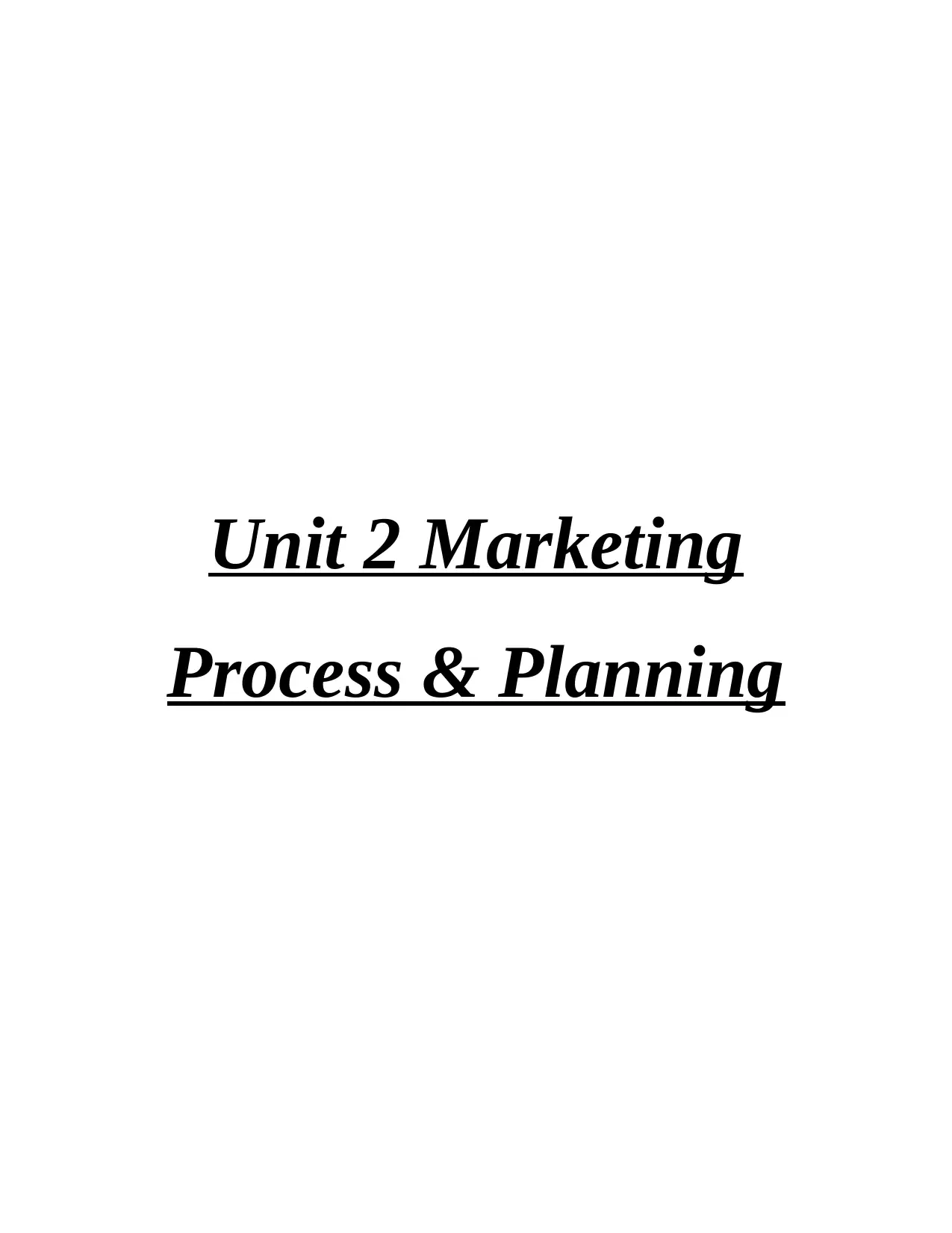
Unit 2 Marketing
Process & Planning
Process & Planning
Paraphrase This Document
Need a fresh take? Get an instant paraphrase of this document with our AI Paraphraser
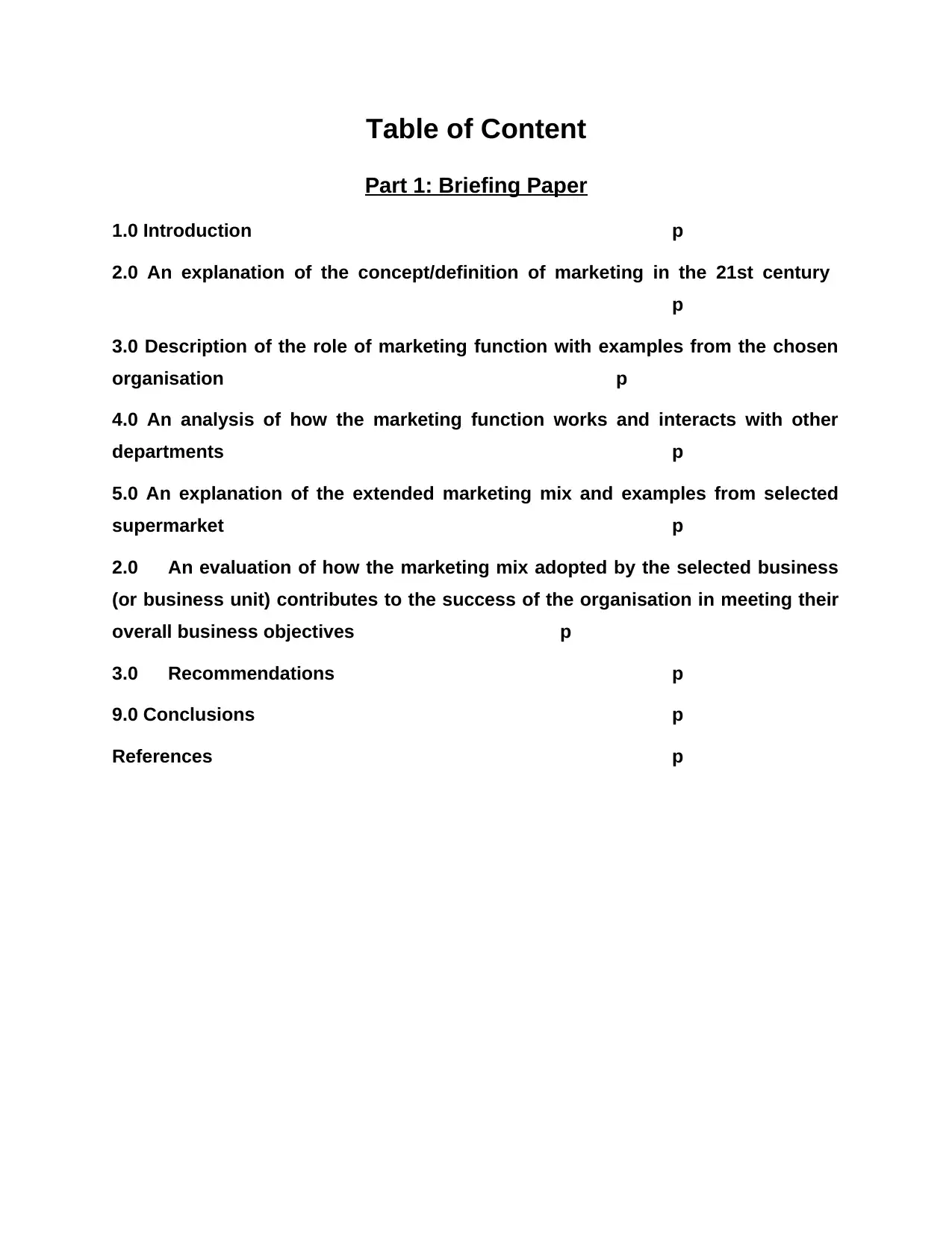
Table of Content
Part 1: Briefing Paper
1.0 Introduction p
2.0 An explanation of the concept/definition of marketing in the 21st century
p
3.0 Description of the role of marketing function with examples from the chosen
organisation p
4.0 An analysis of how the marketing function works and interacts with other
departments p
5.0 An explanation of the extended marketing mix and examples from selected
supermarket p
2.0 An evaluation of how the marketing mix adopted by the selected business
(or business unit) contributes to the success of the organisation in meeting their
overall business objectives p
3.0 Recommendations p
9.0 Conclusions p
References p
Part 1: Briefing Paper
1.0 Introduction p
2.0 An explanation of the concept/definition of marketing in the 21st century
p
3.0 Description of the role of marketing function with examples from the chosen
organisation p
4.0 An analysis of how the marketing function works and interacts with other
departments p
5.0 An explanation of the extended marketing mix and examples from selected
supermarket p
2.0 An evaluation of how the marketing mix adopted by the selected business
(or business unit) contributes to the success of the organisation in meeting their
overall business objectives p
3.0 Recommendations p
9.0 Conclusions p
References p
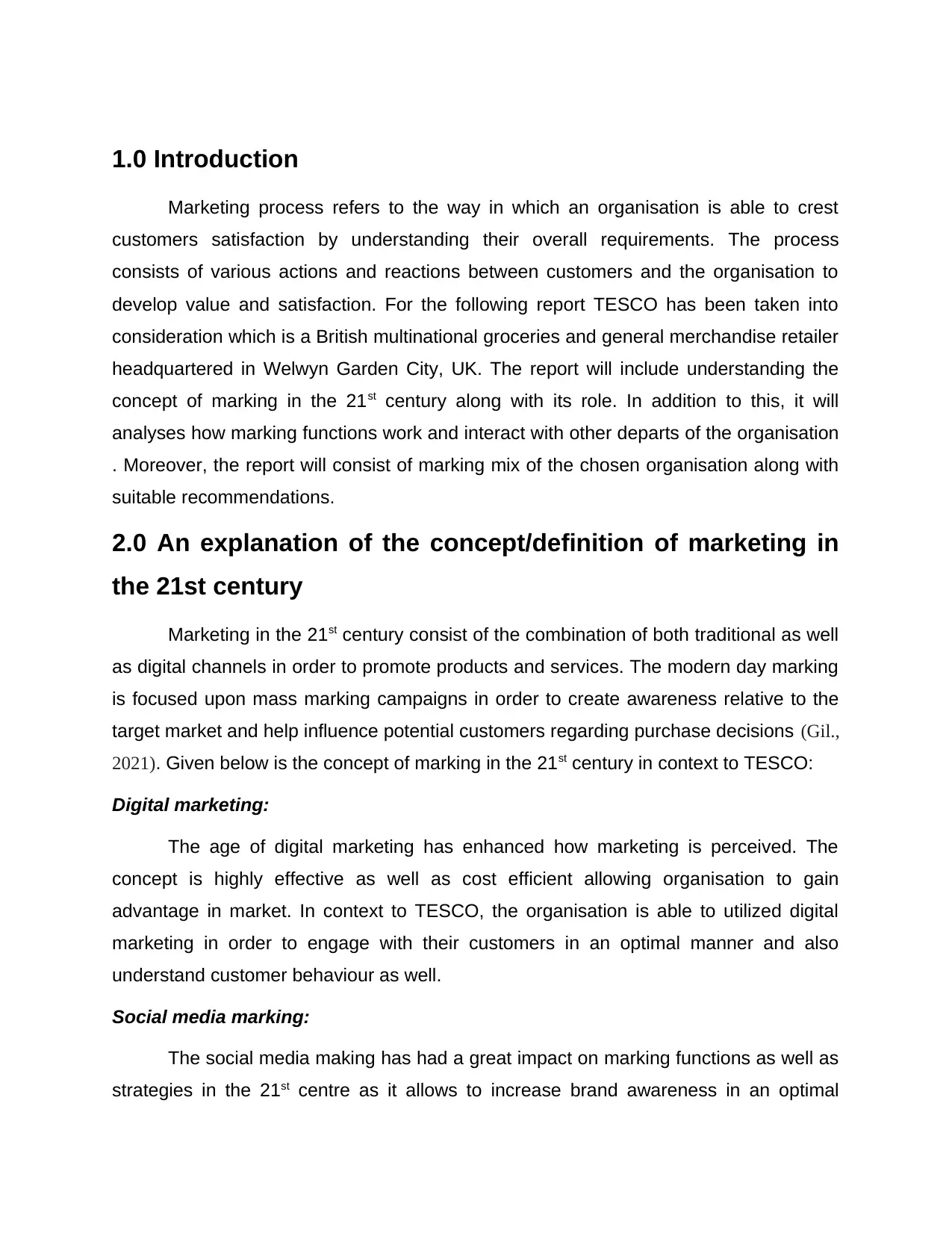
1.0 Introduction
Marketing process refers to the way in which an organisation is able to crest
customers satisfaction by understanding their overall requirements. The process
consists of various actions and reactions between customers and the organisation to
develop value and satisfaction. For the following report TESCO has been taken into
consideration which is a British multinational groceries and general merchandise retailer
headquartered in Welwyn Garden City, UK. The report will include understanding the
concept of marking in the 21st century along with its role. In addition to this, it will
analyses how marking functions work and interact with other departs of the organisation
. Moreover, the report will consist of marking mix of the chosen organisation along with
suitable recommendations.
2.0 An explanation of the concept/definition of marketing in
the 21st century
Marketing in the 21st century consist of the combination of both traditional as well
as digital channels in order to promote products and services. The modern day marking
is focused upon mass marking campaigns in order to create awareness relative to the
target market and help influence potential customers regarding purchase decisions (Gil.,
2021). Given below is the concept of marking in the 21st century in context to TESCO:
Digital marketing:
The age of digital marketing has enhanced how marketing is perceived. The
concept is highly effective as well as cost efficient allowing organisation to gain
advantage in market. In context to TESCO, the organisation is able to utilized digital
marketing in order to engage with their customers in an optimal manner and also
understand customer behaviour as well.
Social media marking:
The social media making has had a great impact on marking functions as well as
strategies in the 21st centre as it allows to increase brand awareness in an optimal
Marketing process refers to the way in which an organisation is able to crest
customers satisfaction by understanding their overall requirements. The process
consists of various actions and reactions between customers and the organisation to
develop value and satisfaction. For the following report TESCO has been taken into
consideration which is a British multinational groceries and general merchandise retailer
headquartered in Welwyn Garden City, UK. The report will include understanding the
concept of marking in the 21st century along with its role. In addition to this, it will
analyses how marking functions work and interact with other departs of the organisation
. Moreover, the report will consist of marking mix of the chosen organisation along with
suitable recommendations.
2.0 An explanation of the concept/definition of marketing in
the 21st century
Marketing in the 21st century consist of the combination of both traditional as well
as digital channels in order to promote products and services. The modern day marking
is focused upon mass marking campaigns in order to create awareness relative to the
target market and help influence potential customers regarding purchase decisions (Gil.,
2021). Given below is the concept of marking in the 21st century in context to TESCO:
Digital marketing:
The age of digital marketing has enhanced how marketing is perceived. The
concept is highly effective as well as cost efficient allowing organisation to gain
advantage in market. In context to TESCO, the organisation is able to utilized digital
marketing in order to engage with their customers in an optimal manner and also
understand customer behaviour as well.
Social media marking:
The social media making has had a great impact on marking functions as well as
strategies in the 21st centre as it allows to increase brand awareness in an optimal
⊘ This is a preview!⊘
Do you want full access?
Subscribe today to unlock all pages.

Trusted by 1+ million students worldwide

manner. In context to TESCO, the organisation is able to use social media platform in
order to promote their products and service as well as provide various offers such as
discounts in order to attract larger customers base (Kotler., 2017).
Personalized advertisements:
The 21st century has allowed organisation to develop personalised marketing
campaigns relative to the engagement of customers and their behaviour towards
organisation products and service. In context to TESCO, the organisation is able toi
utilize this concept of marketing in order to reach their customers expectation in an
effective manner. This allows in establishing positive relations as well as increase
customer satisfaction.
3.0 Description of the role of marketing function with
examples from the chosen organisation
There are various role of marking that assist an organisation in ensuring that its
marking functioning as well as strategies are aligned with objective of increasing
profitability and customer base. Given below are the role of marking function in context
to TESCO:
Promotion:
The organisation is able to effective promote its products and service through
techniques such as digital and social media marking. This allows them effectively
communication information to their customers (Palmatier, Kumar and Harmeling. eds.,
2017).
Selling:
This function of marking allow TESCO to communicate with potential customers
and develop sales lead which further helps in building positive relations with potential
customers.
Product management:
order to promote their products and service as well as provide various offers such as
discounts in order to attract larger customers base (Kotler., 2017).
Personalized advertisements:
The 21st century has allowed organisation to develop personalised marketing
campaigns relative to the engagement of customers and their behaviour towards
organisation products and service. In context to TESCO, the organisation is able toi
utilize this concept of marketing in order to reach their customers expectation in an
effective manner. This allows in establishing positive relations as well as increase
customer satisfaction.
3.0 Description of the role of marketing function with
examples from the chosen organisation
There are various role of marking that assist an organisation in ensuring that its
marking functioning as well as strategies are aligned with objective of increasing
profitability and customer base. Given below are the role of marking function in context
to TESCO:
Promotion:
The organisation is able to effective promote its products and service through
techniques such as digital and social media marking. This allows them effectively
communication information to their customers (Palmatier, Kumar and Harmeling. eds.,
2017).
Selling:
This function of marking allow TESCO to communicate with potential customers
and develop sales lead which further helps in building positive relations with potential
customers.
Product management:
Paraphrase This Document
Need a fresh take? Get an instant paraphrase of this document with our AI Paraphraser
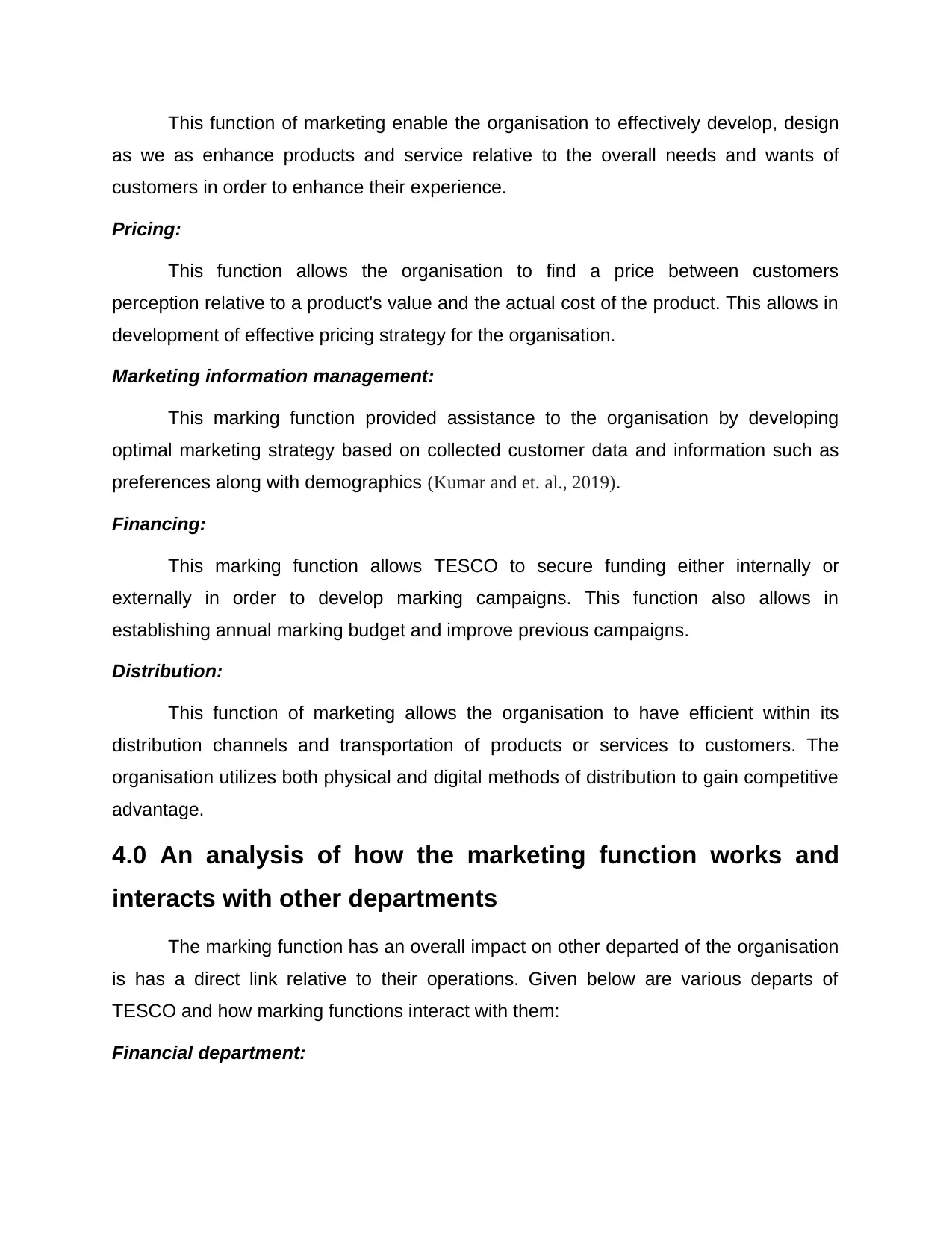
This function of marketing enable the organisation to effectively develop, design
as we as enhance products and service relative to the overall needs and wants of
customers in order to enhance their experience.
Pricing:
This function allows the organisation to find a price between customers
perception relative to a product's value and the actual cost of the product. This allows in
development of effective pricing strategy for the organisation.
Marketing information management:
This marking function provided assistance to the organisation by developing
optimal marketing strategy based on collected customer data and information such as
preferences along with demographics (Kumar and et. al., 2019).
Financing:
This marking function allows TESCO to secure funding either internally or
externally in order to develop marking campaigns. This function also allows in
establishing annual marking budget and improve previous campaigns.
Distribution:
This function of marketing allows the organisation to have efficient within its
distribution channels and transportation of products or services to customers. The
organisation utilizes both physical and digital methods of distribution to gain competitive
advantage.
4.0 An analysis of how the marketing function works and
interacts with other departments
The marking function has an overall impact on other departed of the organisation
is has a direct link relative to their operations. Given below are various departs of
TESCO and how marking functions interact with them:
Financial department:
as we as enhance products and service relative to the overall needs and wants of
customers in order to enhance their experience.
Pricing:
This function allows the organisation to find a price between customers
perception relative to a product's value and the actual cost of the product. This allows in
development of effective pricing strategy for the organisation.
Marketing information management:
This marking function provided assistance to the organisation by developing
optimal marketing strategy based on collected customer data and information such as
preferences along with demographics (Kumar and et. al., 2019).
Financing:
This marking function allows TESCO to secure funding either internally or
externally in order to develop marking campaigns. This function also allows in
establishing annual marking budget and improve previous campaigns.
Distribution:
This function of marketing allows the organisation to have efficient within its
distribution channels and transportation of products or services to customers. The
organisation utilizes both physical and digital methods of distribution to gain competitive
advantage.
4.0 An analysis of how the marketing function works and
interacts with other departments
The marking function has an overall impact on other departed of the organisation
is has a direct link relative to their operations. Given below are various departs of
TESCO and how marking functions interact with them:
Financial department:
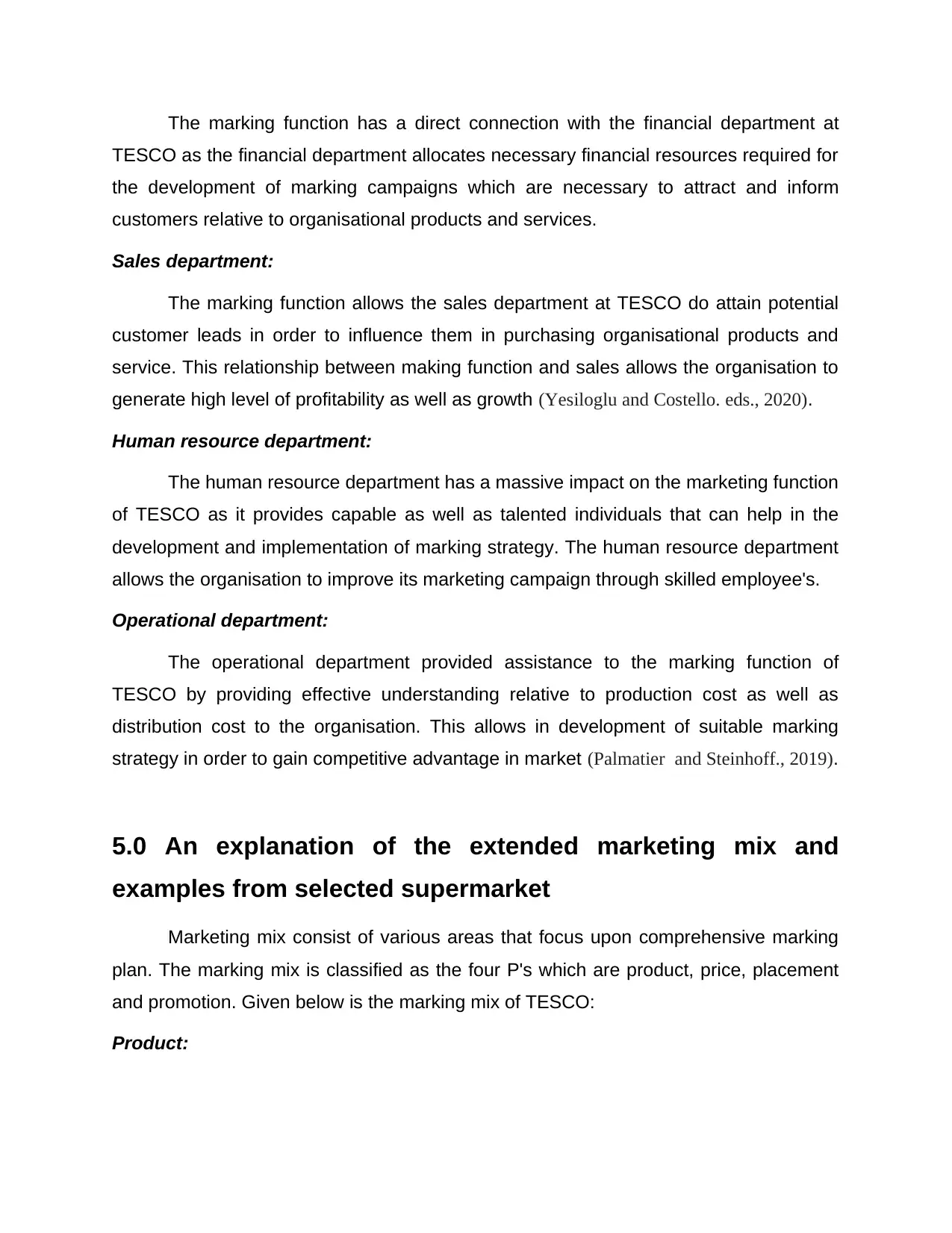
The marking function has a direct connection with the financial department at
TESCO as the financial department allocates necessary financial resources required for
the development of marking campaigns which are necessary to attract and inform
customers relative to organisational products and services.
Sales department:
The marking function allows the sales department at TESCO do attain potential
customer leads in order to influence them in purchasing organisational products and
service. This relationship between making function and sales allows the organisation to
generate high level of profitability as well as growth (Yesiloglu and Costello. eds., 2020).
Human resource department:
The human resource department has a massive impact on the marketing function
of TESCO as it provides capable as well as talented individuals that can help in the
development and implementation of marking strategy. The human resource department
allows the organisation to improve its marketing campaign through skilled employee's.
Operational department:
The operational department provided assistance to the marking function of
TESCO by providing effective understanding relative to production cost as well as
distribution cost to the organisation. This allows in development of suitable marking
strategy in order to gain competitive advantage in market (Palmatier and Steinhoff., 2019).
5.0 An explanation of the extended marketing mix and
examples from selected supermarket
Marketing mix consist of various areas that focus upon comprehensive marking
plan. The marking mix is classified as the four P's which are product, price, placement
and promotion. Given below is the marking mix of TESCO:
Product:
TESCO as the financial department allocates necessary financial resources required for
the development of marking campaigns which are necessary to attract and inform
customers relative to organisational products and services.
Sales department:
The marking function allows the sales department at TESCO do attain potential
customer leads in order to influence them in purchasing organisational products and
service. This relationship between making function and sales allows the organisation to
generate high level of profitability as well as growth (Yesiloglu and Costello. eds., 2020).
Human resource department:
The human resource department has a massive impact on the marketing function
of TESCO as it provides capable as well as talented individuals that can help in the
development and implementation of marking strategy. The human resource department
allows the organisation to improve its marketing campaign through skilled employee's.
Operational department:
The operational department provided assistance to the marking function of
TESCO by providing effective understanding relative to production cost as well as
distribution cost to the organisation. This allows in development of suitable marking
strategy in order to gain competitive advantage in market (Palmatier and Steinhoff., 2019).
5.0 An explanation of the extended marketing mix and
examples from selected supermarket
Marketing mix consist of various areas that focus upon comprehensive marking
plan. The marking mix is classified as the four P's which are product, price, placement
and promotion. Given below is the marking mix of TESCO:
Product:
⊘ This is a preview!⊘
Do you want full access?
Subscribe today to unlock all pages.

Trusted by 1+ million students worldwide
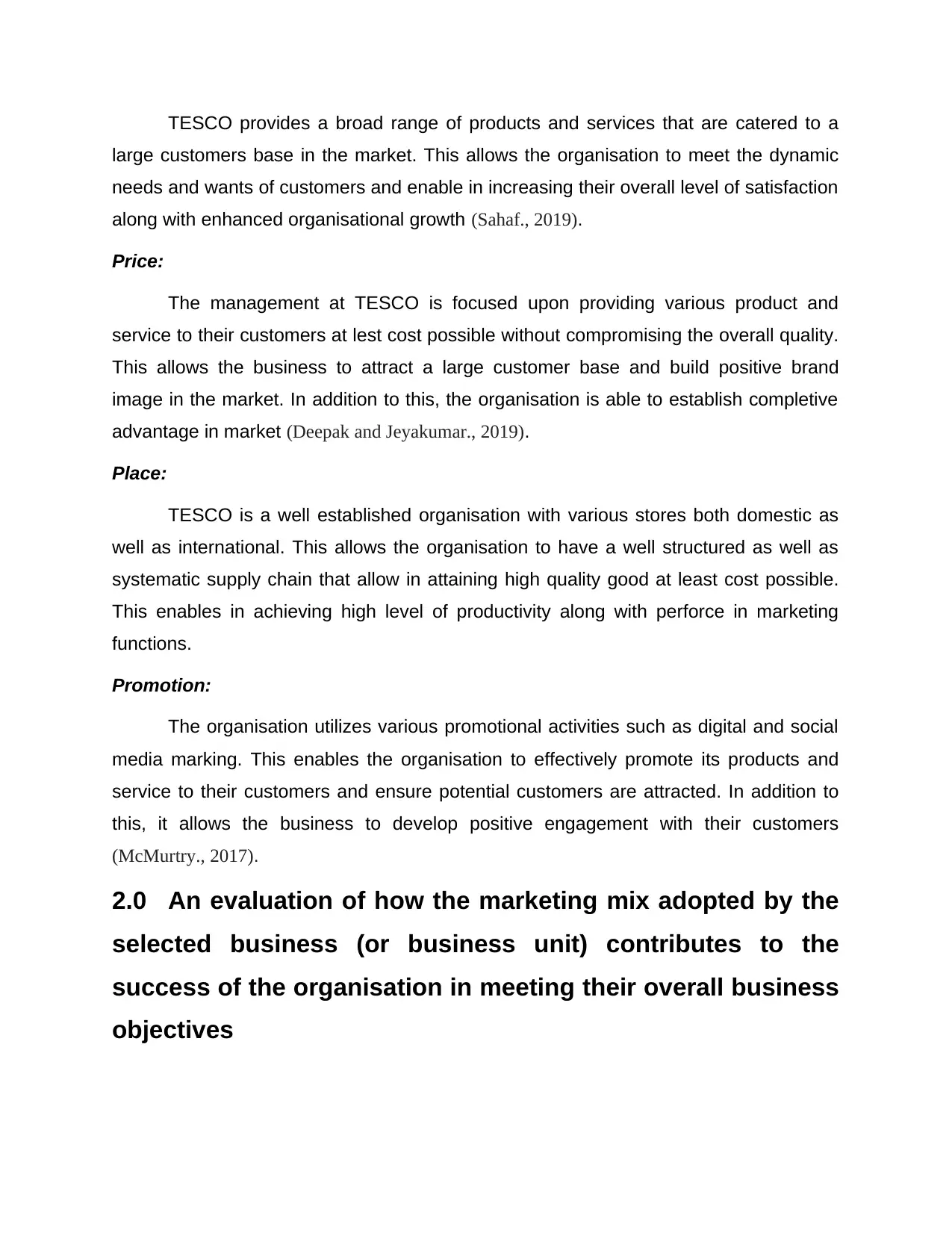
TESCO provides a broad range of products and services that are catered to a
large customers base in the market. This allows the organisation to meet the dynamic
needs and wants of customers and enable in increasing their overall level of satisfaction
along with enhanced organisational growth (Sahaf., 2019).
Price:
The management at TESCO is focused upon providing various product and
service to their customers at lest cost possible without compromising the overall quality.
This allows the business to attract a large customer base and build positive brand
image in the market. In addition to this, the organisation is able to establish completive
advantage in market (Deepak and Jeyakumar., 2019).
Place:
TESCO is a well established organisation with various stores both domestic as
well as international. This allows the organisation to have a well structured as well as
systematic supply chain that allow in attaining high quality good at least cost possible.
This enables in achieving high level of productivity along with perforce in marketing
functions.
Promotion:
The organisation utilizes various promotional activities such as digital and social
media marking. This enables the organisation to effectively promote its products and
service to their customers and ensure potential customers are attracted. In addition to
this, it allows the business to develop positive engagement with their customers
(McMurtry., 2017).
2.0 An evaluation of how the marketing mix adopted by the
selected business (or business unit) contributes to the
success of the organisation in meeting their overall business
objectives
large customers base in the market. This allows the organisation to meet the dynamic
needs and wants of customers and enable in increasing their overall level of satisfaction
along with enhanced organisational growth (Sahaf., 2019).
Price:
The management at TESCO is focused upon providing various product and
service to their customers at lest cost possible without compromising the overall quality.
This allows the business to attract a large customer base and build positive brand
image in the market. In addition to this, the organisation is able to establish completive
advantage in market (Deepak and Jeyakumar., 2019).
Place:
TESCO is a well established organisation with various stores both domestic as
well as international. This allows the organisation to have a well structured as well as
systematic supply chain that allow in attaining high quality good at least cost possible.
This enables in achieving high level of productivity along with perforce in marketing
functions.
Promotion:
The organisation utilizes various promotional activities such as digital and social
media marking. This enables the organisation to effectively promote its products and
service to their customers and ensure potential customers are attracted. In addition to
this, it allows the business to develop positive engagement with their customers
(McMurtry., 2017).
2.0 An evaluation of how the marketing mix adopted by the
selected business (or business unit) contributes to the
success of the organisation in meeting their overall business
objectives
Paraphrase This Document
Need a fresh take? Get an instant paraphrase of this document with our AI Paraphraser

The marking mix allows the management at TESCO to understand what products
and service they can offer to their customers. It also allows the organisation to develop
successful product offences through effective marketing strategies. It allows the
organisation to utilize its strengths and negate unnecessary cost. Given below are how
marketing mix adopted by TESCO hep in meeting its overall business objectives:
Product:
The offering of wide range of product and service by the organisation allow it to
fulfil the objective of catering to a broad customer base. This helps the organisation to
attract a large customer base and attain a larger market share relative to their
competitors.
Price:
The organisation offers its products as well as services at least cost possible.
This allows the organisation to fulfil the objective of provide their customers the highest
level of satisfaction. This improves relations with customers and establishes a loyal
bond which is essential in the long-term (Riswanto and et. al., 2019).
Place:
The business is well established in various domestic as well as international
markets. This allows the organisation to accomplish its business objective of expanding
its market share through their effective brand image as well as optimal marketing
strategies.
Promotion:
The organisation utilizes both tradition and digital forms of marketing which allow
them to reach their customers in an effective manner relative to their products and
services. This enable the organisation to not only understand the perspective of
customers but develop products and service that will be appealing in nature.
3.0 Recommendations
There are various types of marketing strategies that an organisation can adopt in
order to enhance their marking operations. This allows an organisation to ensure that it
and service they can offer to their customers. It also allows the organisation to develop
successful product offences through effective marketing strategies. It allows the
organisation to utilize its strengths and negate unnecessary cost. Given below are how
marketing mix adopted by TESCO hep in meeting its overall business objectives:
Product:
The offering of wide range of product and service by the organisation allow it to
fulfil the objective of catering to a broad customer base. This helps the organisation to
attract a large customer base and attain a larger market share relative to their
competitors.
Price:
The organisation offers its products as well as services at least cost possible.
This allows the organisation to fulfil the objective of provide their customers the highest
level of satisfaction. This improves relations with customers and establishes a loyal
bond which is essential in the long-term (Riswanto and et. al., 2019).
Place:
The business is well established in various domestic as well as international
markets. This allows the organisation to accomplish its business objective of expanding
its market share through their effective brand image as well as optimal marketing
strategies.
Promotion:
The organisation utilizes both tradition and digital forms of marketing which allow
them to reach their customers in an effective manner relative to their products and
services. This enable the organisation to not only understand the perspective of
customers but develop products and service that will be appealing in nature.
3.0 Recommendations
There are various types of marketing strategies that an organisation can adopt in
order to enhance their marking operations. This allows an organisation to ensure that it

is able to effective market its products and services in an effective manner. Given below
are various marketing strategies:
Relationship marketing:
This type of marking strategy is based upon establishing and building customer
loyalty which will ensure that the particular marketing strategy will attract large number
of customers and provide the ability to retain them (Riefa and Clausen., 2019).
Paid advertising:
This form of marking strategy consist of traditions approaches such as television
and print media advertising which can allow an organisation to attract and engage with
a large customer base effectively.
Cause marketing:
The type of marking strategy involves developing a connection between product
and services to a social cause or issue. This allows the business to develop positive
brand image and increase its overall awareness in market (Krasyuk, Kirillova and
Amakhina., 2019).
It is recommended to TESCO that is should pay emphasis on relationship
marketing strategy in order to further enhance their marketing operations. The
organisation has a well established brand image in the market which can be utilize as a
strength in engaging with customers at a higher level. In addition to this, the strategy will
allow the organisation to ensure that the customers are highly satisfied with the
products and services offered by the business. Moreover, the organisation will be able
to attain its customers in an optimal manner.
9.0 Conclusions
From the above report in has been concluded that, marking in 21st century is
highly effective as well as cost efficient relative to tradition marketing. In addition to this,
various role of marking are essential in ensuring that an organisation is able to plan and
implement its marketing strategies in an effective manner. Moreover, the report also
concluded that marking has impact on various other functions of the chosen
are various marketing strategies:
Relationship marketing:
This type of marking strategy is based upon establishing and building customer
loyalty which will ensure that the particular marketing strategy will attract large number
of customers and provide the ability to retain them (Riefa and Clausen., 2019).
Paid advertising:
This form of marking strategy consist of traditions approaches such as television
and print media advertising which can allow an organisation to attract and engage with
a large customer base effectively.
Cause marketing:
The type of marking strategy involves developing a connection between product
and services to a social cause or issue. This allows the business to develop positive
brand image and increase its overall awareness in market (Krasyuk, Kirillova and
Amakhina., 2019).
It is recommended to TESCO that is should pay emphasis on relationship
marketing strategy in order to further enhance their marketing operations. The
organisation has a well established brand image in the market which can be utilize as a
strength in engaging with customers at a higher level. In addition to this, the strategy will
allow the organisation to ensure that the customers are highly satisfied with the
products and services offered by the business. Moreover, the organisation will be able
to attain its customers in an optimal manner.
9.0 Conclusions
From the above report in has been concluded that, marking in 21st century is
highly effective as well as cost efficient relative to tradition marketing. In addition to this,
various role of marking are essential in ensuring that an organisation is able to plan and
implement its marketing strategies in an effective manner. Moreover, the report also
concluded that marking has impact on various other functions of the chosen
⊘ This is a preview!⊘
Do you want full access?
Subscribe today to unlock all pages.

Trusted by 1+ million students worldwide

organisation . Furthermore, the marking mix of the chosen organisation provide insight
on how the organisation can develop effective marking strategy in order to meet its
organisational objectives.
on how the organisation can develop effective marking strategy in order to meet its
organisational objectives.
Paraphrase This Document
Need a fresh take? Get an instant paraphrase of this document with our AI Paraphraser
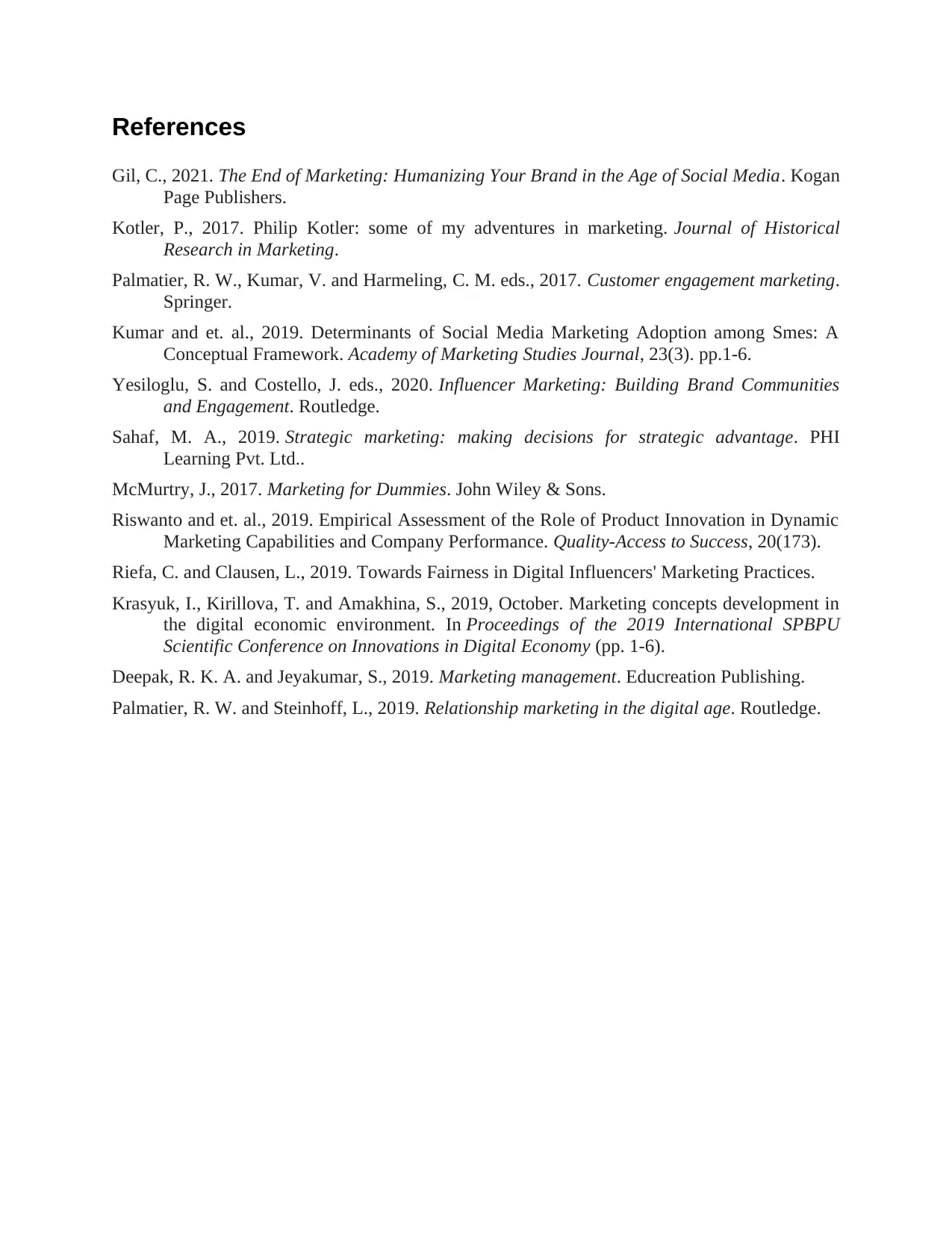
References
Gil, C., 2021. The End of Marketing: Humanizing Your Brand in the Age of Social Media. Kogan
Page Publishers.
Kotler, P., 2017. Philip Kotler: some of my adventures in marketing. Journal of Historical
Research in Marketing.
Palmatier, R. W., Kumar, V. and Harmeling, C. M. eds., 2017. Customer engagement marketing.
Springer.
Kumar and et. al., 2019. Determinants of Social Media Marketing Adoption among Smes: A
Conceptual Framework. Academy of Marketing Studies Journal, 23(3). pp.1-6.
Yesiloglu, S. and Costello, J. eds., 2020. Influencer Marketing: Building Brand Communities
and Engagement. Routledge.
Sahaf, M. A., 2019. Strategic marketing: making decisions for strategic advantage. PHI
Learning Pvt. Ltd..
McMurtry, J., 2017. Marketing for Dummies. John Wiley & Sons.
Riswanto and et. al., 2019. Empirical Assessment of the Role of Product Innovation in Dynamic
Marketing Capabilities and Company Performance. Quality-Access to Success, 20(173).
Riefa, C. and Clausen, L., 2019. Towards Fairness in Digital Influencers' Marketing Practices.
Krasyuk, I., Kirillova, T. and Amakhina, S., 2019, October. Marketing concepts development in
the digital economic environment. In Proceedings of the 2019 International SPBPU
Scientific Conference on Innovations in Digital Economy (pp. 1-6).
Deepak, R. K. A. and Jeyakumar, S., 2019. Marketing management. Educreation Publishing.
Palmatier, R. W. and Steinhoff, L., 2019. Relationship marketing in the digital age. Routledge.
Gil, C., 2021. The End of Marketing: Humanizing Your Brand in the Age of Social Media. Kogan
Page Publishers.
Kotler, P., 2017. Philip Kotler: some of my adventures in marketing. Journal of Historical
Research in Marketing.
Palmatier, R. W., Kumar, V. and Harmeling, C. M. eds., 2017. Customer engagement marketing.
Springer.
Kumar and et. al., 2019. Determinants of Social Media Marketing Adoption among Smes: A
Conceptual Framework. Academy of Marketing Studies Journal, 23(3). pp.1-6.
Yesiloglu, S. and Costello, J. eds., 2020. Influencer Marketing: Building Brand Communities
and Engagement. Routledge.
Sahaf, M. A., 2019. Strategic marketing: making decisions for strategic advantage. PHI
Learning Pvt. Ltd..
McMurtry, J., 2017. Marketing for Dummies. John Wiley & Sons.
Riswanto and et. al., 2019. Empirical Assessment of the Role of Product Innovation in Dynamic
Marketing Capabilities and Company Performance. Quality-Access to Success, 20(173).
Riefa, C. and Clausen, L., 2019. Towards Fairness in Digital Influencers' Marketing Practices.
Krasyuk, I., Kirillova, T. and Amakhina, S., 2019, October. Marketing concepts development in
the digital economic environment. In Proceedings of the 2019 International SPBPU
Scientific Conference on Innovations in Digital Economy (pp. 1-6).
Deepak, R. K. A. and Jeyakumar, S., 2019. Marketing management. Educreation Publishing.
Palmatier, R. W. and Steinhoff, L., 2019. Relationship marketing in the digital age. Routledge.
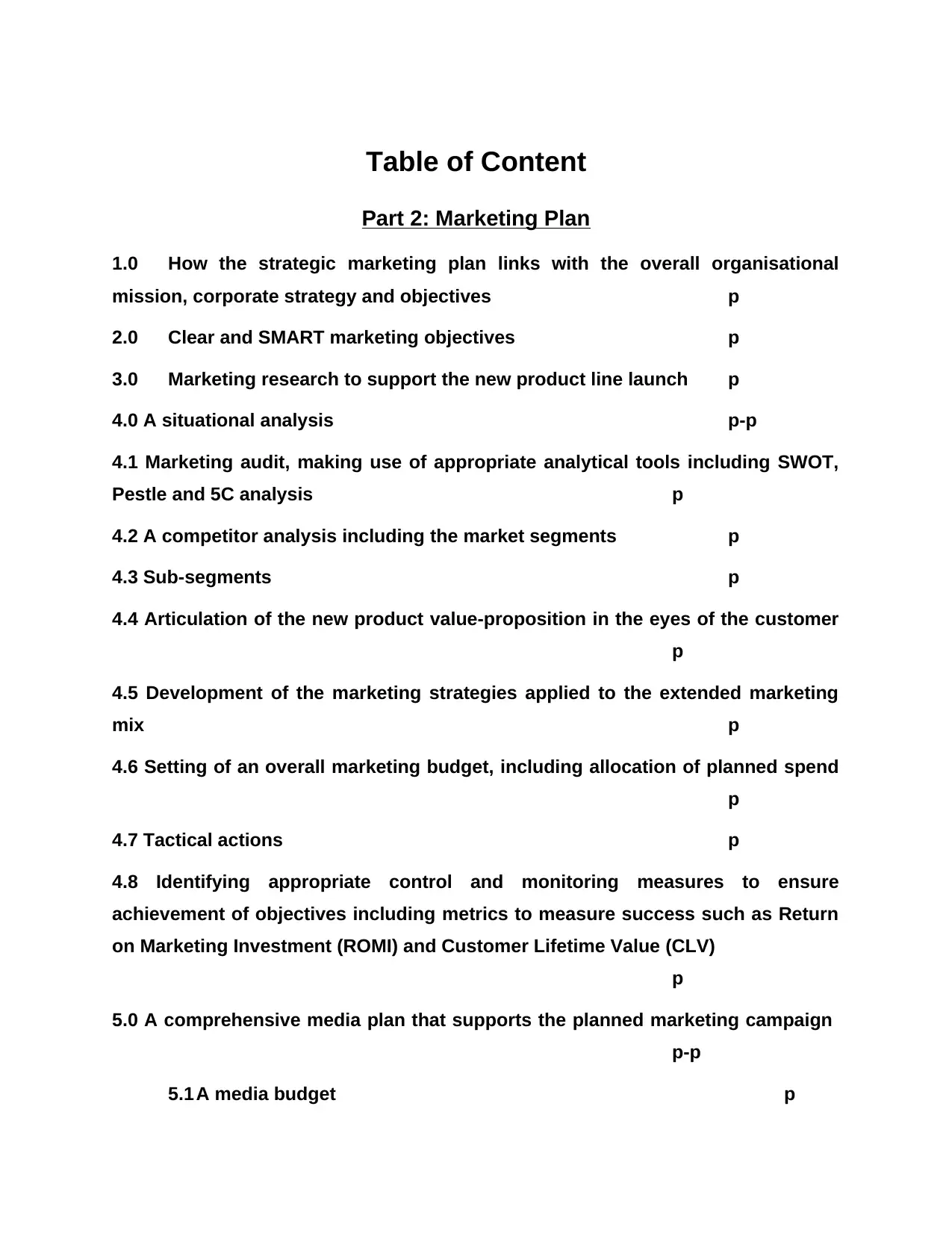
Table of Content
Part 2: Marketing Plan
1.0 How the strategic marketing plan links with the overall organisational
mission, corporate strategy and objectives p
2.0 Clear and SMART marketing objectives p
3.0 Marketing research to support the new product line launch p
4.0 A situational analysis p-p
4.1 Marketing audit, making use of appropriate analytical tools including SWOT,
Pestle and 5C analysis p
4.2 A competitor analysis including the market segments p
4.3 Sub-segments p
4.4 Articulation of the new product value-proposition in the eyes of the customer
p
4.5 Development of the marketing strategies applied to the extended marketing
mix p
4.6 Setting of an overall marketing budget, including allocation of planned spend
p
4.7 Tactical actions p
4.8 Identifying appropriate control and monitoring measures to ensure
achievement of objectives including metrics to measure success such as Return
on Marketing Investment (ROMI) and Customer Lifetime Value (CLV)
p
5.0 A comprehensive media plan that supports the planned marketing campaign
p-p
5.1 A media budget p
Part 2: Marketing Plan
1.0 How the strategic marketing plan links with the overall organisational
mission, corporate strategy and objectives p
2.0 Clear and SMART marketing objectives p
3.0 Marketing research to support the new product line launch p
4.0 A situational analysis p-p
4.1 Marketing audit, making use of appropriate analytical tools including SWOT,
Pestle and 5C analysis p
4.2 A competitor analysis including the market segments p
4.3 Sub-segments p
4.4 Articulation of the new product value-proposition in the eyes of the customer
p
4.5 Development of the marketing strategies applied to the extended marketing
mix p
4.6 Setting of an overall marketing budget, including allocation of planned spend
p
4.7 Tactical actions p
4.8 Identifying appropriate control and monitoring measures to ensure
achievement of objectives including metrics to measure success such as Return
on Marketing Investment (ROMI) and Customer Lifetime Value (CLV)
p
5.0 A comprehensive media plan that supports the planned marketing campaign
p-p
5.1 A media budget p
⊘ This is a preview!⊘
Do you want full access?
Subscribe today to unlock all pages.

Trusted by 1+ million students worldwide
1 out of 22
Related Documents
Your All-in-One AI-Powered Toolkit for Academic Success.
+13062052269
info@desklib.com
Available 24*7 on WhatsApp / Email
![[object Object]](/_next/static/media/star-bottom.7253800d.svg)
Unlock your academic potential
Copyright © 2020–2025 A2Z Services. All Rights Reserved. Developed and managed by ZUCOL.


